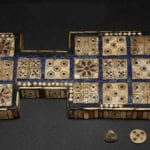 Mysteries
Mysteries  Mysteries
Mysteries  History
History 10 Surprising Stories About the Texas Rangers
 Humans
Humans 10 Philosophers Who Were Driven Mad by Their Own Theories
 Miscellaneous
Miscellaneous 10 Video-Game-Worthy Weapons and Armors from History
 Weird Stuff
Weird Stuff 10 Psychics Who Accurately Predicted Wartime Events
 The Arts
The Arts 10 Pieces of Art Inspired by a Broken Heart
 Health
Health 10 Science Fiction-Sounding New Medical Treatments
 History
History 10 Surprising Facts About the Father of Submarine Warfare
 Space
Space Ten Astonishing New Insights into Alien Worlds
 Weird Stuff
Weird Stuff 10 Bizarre Summer Solstice Rituals Still Practiced Today
 Mysteries
Mysteries Top 10 Haunting Facts About the Ghost Ship MV Alta
 History
History 10 Surprising Stories About the Texas Rangers
 Humans
Humans 10 Philosophers Who Were Driven Mad by Their Own Theories
Who's Behind Listverse?

Jamie Frater
Head Editor
Jamie founded Listverse due to an insatiable desire to share fascinating, obscure, and bizarre facts. He has been a guest speaker on numerous national radio and television stations and is a five time published author.
More About Us Miscellaneous
Miscellaneous 10 Video-Game-Worthy Weapons and Armors from History
 Weird Stuff
Weird Stuff 10 Psychics Who Accurately Predicted Wartime Events
 The Arts
The Arts 10 Pieces of Art Inspired by a Broken Heart
 Health
Health 10 Science Fiction-Sounding New Medical Treatments
 History
History 10 Surprising Facts About the Father of Submarine Warfare
 Space
Space Ten Astonishing New Insights into Alien Worlds
 Weird Stuff
Weird Stuff 10 Bizarre Summer Solstice Rituals Still Practiced Today
Top 10 Most Important Video Games Of The 1970s
Video games became popular throughout the world in the 1980s, but they weren’t invented in that decade. In fact, the first video game came into existence in October 1958, though it took some time for the format to evolve.
By the 1970s, video games were more widely available, and some of the best games of that decade were incredibly important. These ten games were developed and released in the ’70s, and they helped pave the way for every game that followed.
10 Ancient Board Games That Inspired Modern Games
10 Galaxian (1979)
In 1977, the world was gifted with Star Wars, and the film inspired people all around the world. One person who took a great deal of inspiration from the movie was Kazunori Sawano, the designer of Galaxian.
The Namco/Midway classic takes a lot of inspiration from Star Wars. It introduced numerous innovations that would ultimately inspire a whole genre of video games. In Galaxian, the player takes control of a Galaxip starfighter as they defend Earth from formations of alien vessels.
When the game was first designed, the enemies looked like TIE Fighters from Star Wars, but this was changed to more bug-like aliens. Galaxian was designed primarily to combat rival company Taito’s success with Space Invaders, and it was incredibly successful.
Galaxian broke new ground, as it was one of the first games to feature RGB color graphics. It could also animate multi-color sprites while scrolling the screen, making it incredibly more complex than the competition.
Galaxian’s success led to its sequel Galaga in 1981. It has also inspired numerous games that followed, including 1941, Time Pilot, and just about any game where a player controls a ship battling enemies.
9 Lunar Lander (1979)
A decade after mankind (maybe) landed on the Moon, Atari released a game that let people try the same thing, albeit with less at stake. Lunar Lander is a vector game that depicts a lunar landing module as it descends toward the surface of the Moon. The player rotates the module and burns fuel via a thruster to gently land on targeted areas.
Whether you’re successful or not, the scenario resets with different terrain, letting players continue trying until they run out of fuel. A new quarter buys additional fuel, making it possible to continue playing (for a price).
The game was innovative, as it employed a feature that made the game more profitable for arcade owners. By allowing players to continue playing at the cost of another quarter, the game proved it was possible to make more money from anyone willing to continue playing. This was long before saving a game was possible, so it marked a significant change for gaming.
Additionally, the physics used to control the lunar module was incredibly well done. It offers a realistic approximation of the real thing, which few games were capable of doing in the 1970s.
8 Breakout (1976)
Nolan Bushnell created Pong, but he wanted to continue exploring the concept, so he co-created Breakout in 1976. Breakout is very much like Pong, but it’s a single-player game that uses the same paddle controller. Instead of hitting a ball to try and score against an opponent, the player hits it to take out bricks from a wall.
He enlisted the help of Steve Jobs (who worked at Atari at the time) to design the game. Jobs brought Steve Wozniak over from Hewlett-Packard. They worked hard to put it together with as few chips as possible. The goal was to combat the numerous Pong clones that flooded the market, and it pretty much worked.
Breakout was incredibly successful for Atari, but more than that, it created a new genre of gaming. Technically, 1974’s Clean Sweep came first, but it was Breakout that made screen-clearing something players wanted to do, and that influence led to tons of similar games.
If you’ve ever played a game that involved removing objects from a screen, you can thank Breakout’s success. If you want to check it out, all you need to do is go to Google.com, search for “Atari Breakout,” and hit “I’m Feeling Lucky.”
7 Sea Wolf (1976)
At a time when most video games involved staring at a monitor, Midway decided to do something different. Sea Wolf is a shooter that places the player inside a submarine. They then look onto a screen with ships moving along the sea line, and they fire torpedoes to destroy them.
Instead of just looking at a screen, Sea Wolf had a swiveling periscope that moved to the left and right. Its horizontal motion created a realistic targeting scope for the player to find ships and destroy them. While the graphics weren’t awe-inspiring, the gameplay was entertaining and immersive.
Sea Wolf was also one of the first games to incorporate a saved high score, which is a feature that became prevalent soon afterward. It also pushed people to try and outperform their friends to get the highest score, making the game relatively profitable through competition.
Many players remember this game more for its beautifully designed and innovative cabinet over its actual gameplay. Its success led to a color sequel a couple of years later. It also helped influence the design of 1980’s Battlezone, which employs a similar viewscreen/periscope.
6 Zork (1977)
Back when programmers were wracking their brains trying to find new and innovative ways of displaying images on a computer screen, a group of four students at MIT was working on a text-based game. Though it isn’t the first and built off of innovations made in 1976’s Colossal Cave Adventure, Zork became one of the most important games of the 1970s.
Before Colossal Cave Adventure and Zork, games didn’t tell a story. They involved some minor action and player control, but there wasn’t any sort of cohesive tale. These games changed all of that by creating immersive worlds through descriptive text, and not a single image was rendered.
In Zork, the player controls the story by inputting directions and actions they want their adventurer to take. The goal is to return from the “Great Underground Empire” with specific treasures needed to complete the adventure.
Zork’s success proved that there were gamers who wanted to play engrossing story-based adventures. From Zork came other text-based games, but they eventually evolved into modern video game role-playing games that continue to dominate the industry to this day.
5 Space Invaders (1978)
In Space Invaders, the player controls a small cannon that moves horizontally across the screen. Protecting it are four green barriers, which degrade as they are hit by friendly or enemy fire. A fleet of insectoid spacecraft makes their way down toward the player, getting faster as they get closer while flying saucers move atop the screen.
The game is relatively simple while still dynamic and difficult for players to master. It wasn’t the first game that let you shoot down alien spacecraft, but it was one of the first that had those same ships fire back at the player.
The game featured several innovations that would become common across the industry. The most notable was the inclusion of a continuous background soundtrack, which was a simple repetitive series of bass notes played on a loop.
Space Invaders was one of the most successful video games ever developed. Taito sold so many units, new arcades were built to focus on the game — it was that popular. It even caused a coin shortage in Japan until the government quadrupled the Yen supply.
4 Asteroids (1979)
Atari’s Asteroids may look like a simple game, but it’s anything but simple. The game allows the player to control a spaceship stuck in an asteroid field. While trying to destroy and avoid the asteroids, flying saucers show up and attack. The player can remain stationary or move by either using their thrusters or hyperspace jumping to a random location.
Like most games of the era, the longer you play, the harder it gets. Asteroids is definitely one of the more challenging games of the period. It’s also considered one of the first successful arcade cabinets to come out during the Golden Age of Arcade Games. Asteroids was comparatively simple to what followed, but it influenced a ton of programmers.
Asteroids was ridiculously popular when it was released. You can see it in the background of numerous films and TV shows from the era. It quickly passed Space Invaders in sales, with more than 70,000 units shipped out to arcades worldwide. It broke records and became Atari’s best-selling game of all time.
While Atari took home around $150 million ($490 million in 2021) from sales, arcade owners saw more than $500 million ($1.6 billion in 2021) from all the quarters dropped into the coin slot by the end of 1980.
3 Computer Space (1971)
Few people these days have ever heard of Computer Space despite its place in history. The game was developed by Nolan Bushnell and Ted Dabney (the future co-founders of Atari) in 1971. It became the first arcade video game and the first commercially available video game in the world.
The game’s most notable feature wasn’t the gameplay or the graphics; it was the cabinet. The sleek fiberglass cab featured curves and looked otherworldly. It even made a cameo appearance in 1973’s Soylent Green, as it looked incredibly futuristic.
Computer Space was a redesigned version of the 1962 computer game Spacewar!, but with the ability to accept coins. It featured a starscape where the player controlled a ship that fired on two computer-controlled UFOs. It was relatively simple but innovative. Computer Space sold 1,500 units, but it wasn’t a huge financial success.
It proved there was a market for coin-operated arcade games, but it never took off in popularity. Bushnell and Dabney formed Atari shortly after, and in June of 1972, they launched Atari with the far more successful game Pong. Computer Space’s most significant mark on history was the establishment of arcade cabinet norms that would be seen in every cab that followed.
2 The Oregon Trail (1975)
In 1971, Don Rawitsch, Bill Heinemann, and Paul Dillenberger teamed up to create The Oregon Trail to teach 8th graders about the realities of life in the 19th century for pioneers who took the Oregon Trail. The game wasn’t published when it was created, but it did lead to a series of games published over the next 50 years.
In 1974, the Minnesota Educational Computing Consortium (MECC) hired Rahitsch, who loaded the game’s code onto the MECC’s shared network. When he did this, he modified the game’s details to improve the historical accuracy. The following year, the game was retitled to OREGON and was published to every school on the network.
It quickly became the most popular game on the MECC network, with thousands of people playing it every month. Rawitsch soon published the source code. Soon, schools outside the network began featuring the game for their students on the newly-adopted Apple II.
Over the years, OREGON reverted back to Oregon Trail and received various updates. The game helped educate millions of children, and it helped shape the educational game industry. It remains incredibly popular and was recently re-released as a handheld game by Basic Fun.
1 Pong (1972)
You may have heard that Pong was the first video game, but that’s not true. In fact, it wasn’t even the first tennis game. Despite those facts, Pong is widely remembered for being one of the most important games in the video game industry, and that’s not hyperbole.
Pong may not have come first, but it did something that no other game did before it. It proved the profitability of video games, paving the way for the arcade and home consoles. Without Pong, it’s possible neither of those things would have come about, making Pong the most important game of the 1970s.
When the first game proved to be a smash hit in the summer of ’72, Atari pushed forward with manufacturing to produce cabinets by the end of the year. Three years later, a home version hit the market, which spawned dozens of clones.
It was finally possible to play video games at home, and the market was absolutely dominated with Pong games and clones. Pong got people interested in video games before most people had ever played them, and it’s all thanks to a couple of paddles, a square “ball,” electronic sounds, and a scoring system.
Top 10 Influential Arcade Games





![Top 10 Most Important Nude Scenes in Movie History [Videos] Top 10 Most Important Nude Scenes in Movie History [Videos]](https://listverse.com/wp-content/uploads/2019/09/sharonstone-150x150.jpg)


